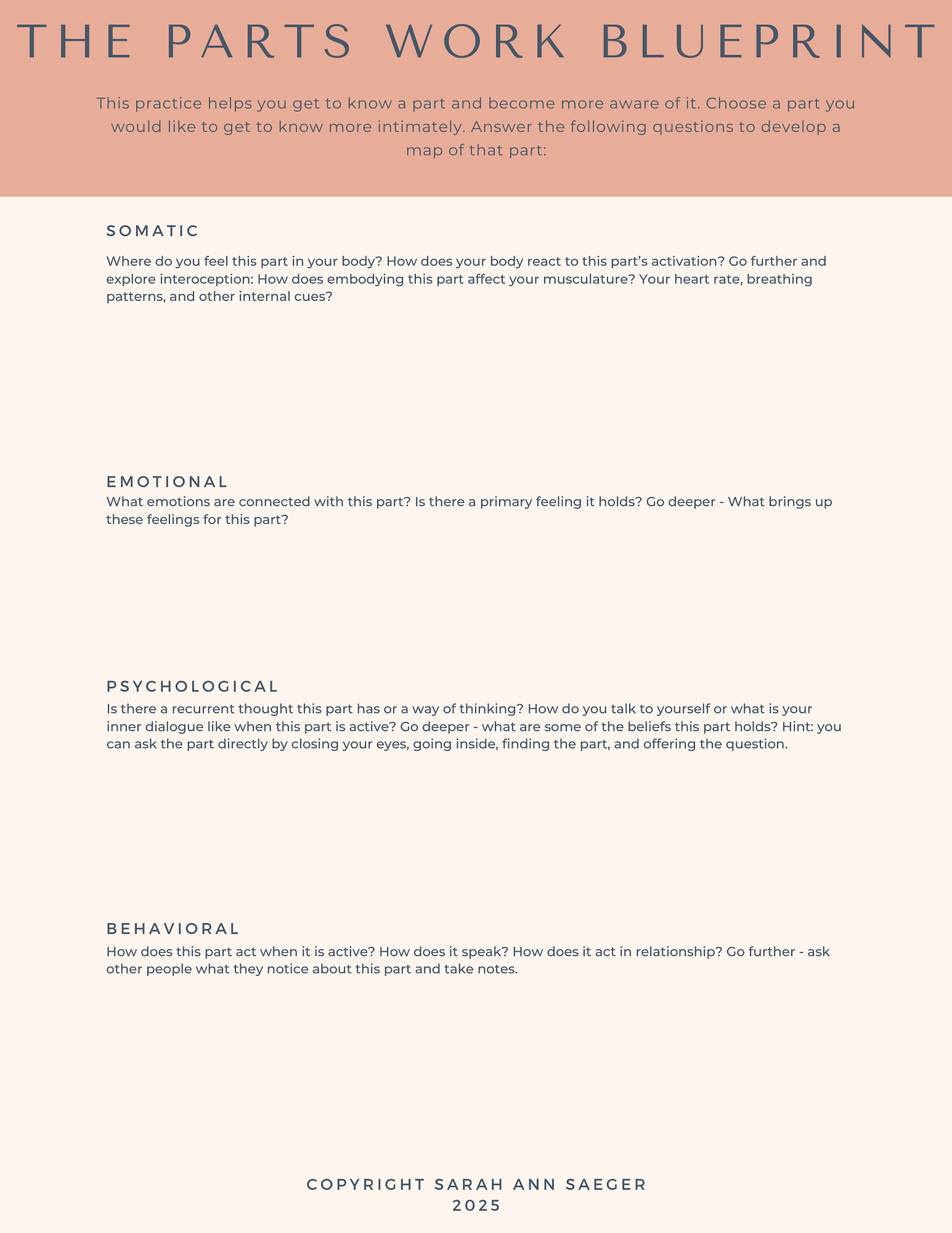How to Re-Parent The Parts of You That Grew up Too Fast
An IFS Inner Parenting Guide For Working With Parentified Parts
foreword
Welcome to Whole Self! Every Sunday, I send out an offering which expands upon a concept related to parts work and post-traumatic growth. This is free, so if you subscribe you will receive this.
A brief note on me: my name is Sarah Ann Saeger and I am a licensed IFS therapist, writer, and post-lineage yoga teacher. My mission is to help you embrace the embodied wisdom of your whole self. You can find me on Instagram where I share short-form musings & lessons related to parts work with over 100k followers!
Last, here are some key concepts that can help you if you’re new to IFS:
Internal Family Systems (IFS) - a compassion-focused, evidence-based psychotherapy based on the assumption that healing happens when we seek to be with our internal experience (or inner world of parts) rather than “fix” or “change” it
Part - an inner complex, sub-personality, or version of yourself that exists with an agenda, emotion, job, memory state, somatic sensation, or belief
Self or Self-energy - the awareness that can hold all parts; compassionate, curious awareness; loving presence; awareness without an agenda
Parts work - the practice of healing your parts through witnessing, listening, and supporting them
Last, please consider supporting the journal with a paid subscription. This not only unlocks exclusive posts, parts work practices, and offerings for you, but it helps keep the creative career going. Thank you.
Happy reading and thank you for supporting my work!
You’ve heard of gentle parenting for children, but what about inner parenting for the young parts of you in need of safety, responsiveness, and nurturing?
Parentified adult children, or children who grew up feeling like a parent to their parent, often have sophisticated protector parts that shimmer with competence and perfectionism. If you can relate to this background, your protectors might possess strong caretaking skills or organization tendencies. You might be the go-to person at work who everyone relies on for your problem-solving talents, the caring nurturer in a friend group who remembers everyone’s birthdays, or the golden child in your family of origin who dutifully procured good grades and completed her chores without a fuss.
The nature of parentified parts is that they compensate for their parent’s helplessness and their own vulnerability with adult disguises.
Heller & Kammer (2020) wisely note in NARM Personality Spectrum, “A client’s capacity to function in the world can actually be in service of “child consciousness” survival strategies (p.15).” Parentified adult children often don’t look like their histories because they function so well in the world. Ironically, this performance of high functioning is an expression of what Heller defines as a “child consciousness survival strategy.” High functioning protector parts still arise from child consciousness, which is concerned with survival and attachment needs. If you are a parentified adult child, this means that when you appear at the height of competency and intelligence, you might be relying on skills you learned in childhood to defend against the fear of danger and pain of parental neglect.
Parentified protector parts exist because they lacked a reliable caregiver to meet their emotional and physiological needs. These parts are skilled at caretaking and have streaks of hyper-independence because they learned to meet other people’s needs and their own so well. Due to their histories, these parts are often resistant to attempts to fix, change, or control them. Fortunately, there is a way to get into relationship with these parts to support them with their functions, help them step back from states of overdrive, and heal the hurts that they protect.
You can reparent the parts of you that are parentified.
You can be their secure attachment base and exude what Internal Family Systems Therapy (IFS) calls Self-leadership and Neuro-Affective Relational Model (NARM) calls adult consciousness. In this post, I’ll detail 5 IFS-inspired practices that can help you commence the practice of inner parenting with these parentified parts. Although these parts appear adultlike, they are encapsulated in childlike states with unmet attachment needs. Inner parenting cultivates healthy inner attachment which heals and supports these parts.
psst: future parts work practice posts will have a paywall but this week’s post is complimentary to all subscribers! Do consider supporting the journal if you are able to do so, which not only unlocks exclusive posts, PDFs, and offerings, but it also supports my creative career. Thank you.
5 IFS-INSPIRED INNER PARENTING PRACTICES:
1. NOTICE YOUR PROTECTORS WHEN THEY’RE ACTIVE
Just as you would observe and pay attention to your own child, take notice of your parentified protectors when they’re active. How do they show up in your body? Is there an emotion or a thought connected to their presence? How do they act out? Observe their somatic, emotional, psychological, and behavioral signatures. This gives you a blueprint to noticing them when they are activated instead of blending with them unconsciously, a term we use in IFS to denote times when parts merge with our awareness instead of our awareness consciously holding them.
When we notice protectors, we can get into relationship with them and lead the internal system with connection.
(psst: scroll to the bottom of this post for a complimentary PDF, The Parts Work Blueprint, to explore this practice more in depth)
2. ACKNOWLEDGE THEIR CAPABILITIES AND JOBS
Parentified protector parts are especially adept at managing responsibilities and accomplishing tasks. They are highly skilled, intelligent, and resourceful. Just as young children need encouragement for their strengths and successes, parentified protector parts benefit from validation. They might act like they don’t need the validation, but acknowledging their talents and efforts helps them feel seen and respected. These parts are used to not being recognized due to how they had to function in the family system, which was taking on the lion’s share of mental, emotional, and logistical labor thanklessly. Communicate your respect for their tremendous capabilities. Are there specific memories you have of when they helped you? How have they contributed positively to your life? What do you appreciate about them? From a space of Self-energy, or loving presence, validate their efforts.
3. VALIDATE THEIR FEARS AND CONCERNS
The stronger the protective response, the more profound the vulnerability.
Strong parentified protectors safeguard all of the vulnerabilities of your child self: helplessness to change the parent’s struggles, fear in response to the parent’s unpredictability, and shame for having needs and struggles of your own. These vulnerable feelings were not safe to access and feel as a young child, which is where protector parts step in. These parts are afraid of the intense emotions flooding the internal system. They perform their jobs to both prevent the parts holding these emotions from getting triggered again and to avoid being consumed by emotion. You can validate a protector’s fears by asking, What are you afraid might happen if you stop doing your job? Listen attentively to the answer and validate why this makes sense for your part. Just as a young child needs patience and presence to process their fears, so do your parentified protector parts.
4. ASK THEM WHAT THEY WOULD PREFER TO DO INSTEAD
When children perceive that they have choices, their sense of autonomy and security increases. This leads to greater emotional regulation and cognitive flexibility as their personhood is respected. Similarly, parentified protectors flourish when they have options. Remember, their story is that they had to take on their jobs of protection because if they didn’t, an unthinkable outcome would happen, such as a parent completely falling apart. Asking your parentified protectors what they would like to do instead of their jobs can bring some agency back to their awareness. This reminds them that they have choices and moves them toward more affirming options instead of staying stuck in the outdated, stressful role.
5.SPEND TIME BUILDING THE SELF TO PART RELATIONSHIP
Children thrive when their attention and connection bucket is full. Parentified protector parts possess this attachment need which you can meet by offering them presence. To build this relationship, you begin with noticing (circle back to Practice #1) and expand it to asking them where they would like to go and what they would like to do. This can be something tangible that you can do in your life today or something more abstract that you can imagine yourself doing with your part(s).
Once parentified protector parts are given this kind of attention, they are happy to explore interests, passions, and hobbies that your child self would have enjoyed.
Get curious and be open to their feedback!
Remember to thank your parts for their feedback and guidance as you conclude these practices. Remember to revisit them with their consent. And remember to be gentle with your system, your process, and your pace as you explore parts work practices.
Always believing in the gifts and genius of your parts,
Sarah
p.s. See the Parts Work Blueprint below for helpful questions and tools to get to know a part more intimately.
About Me:
Hi, I’m Sarah.
I am an IFS trauma therapist, parts work mentor, writer, yoga teacher, wife, and mother. I help you become who you needed when you were younger with parts work and inner parenting. My mission is to help people embody the wisdom of their whole self after trauma and parentification. You can find me on Instagram, where I share musings on complex trauma recovery and integrated motherhood with over 100,000 followers, as well as on my Substack journals Whole Self and Integrated Motherhood.
Apart from my professional work, I know what it’s like to walk the nonlinear path of trauma and addiction recovery. I offer understanding and support to those living lives and creating families that contradict childhoods where they felt unsafe and unseen.
My journey of post-traumatic growth has shown me the power of getting into relationship with my parts rather than trying to change them, and developing curiosity and kinship with my inner world as I integrate all the parts to be found there. As you navigate your journey of parts work and trauma recovery, remember that healing is always possible for your parts, and your parts make perfect sense and love you fiercely.
Here’s how you can connect with my work further:
Support the journal by subscribing. Consider being a paid subscriber to get access to exclusive posts and offerings. If that’s not feasible right now, consider sharing the journal with someone else or leaving a comment!
Apply for IFS coaching & parts work mentorship — for post-traumatic growth, creative reclamation, and relational intimacy. I am especially passionate about supporting creatives, helping professionals, mothers, couples, and folks in long-term trauma and addiction recovery.








Thank you for this well thought out and arranged way of understanding our parts! My life has been transformed by understanding how my inner landscape is arranged.
This was an incredible read, Sarah. IFS and Parts Work wholly changed my life 3 years ago. It’s great to see it being taught & discussed here. 🫶🏻✨